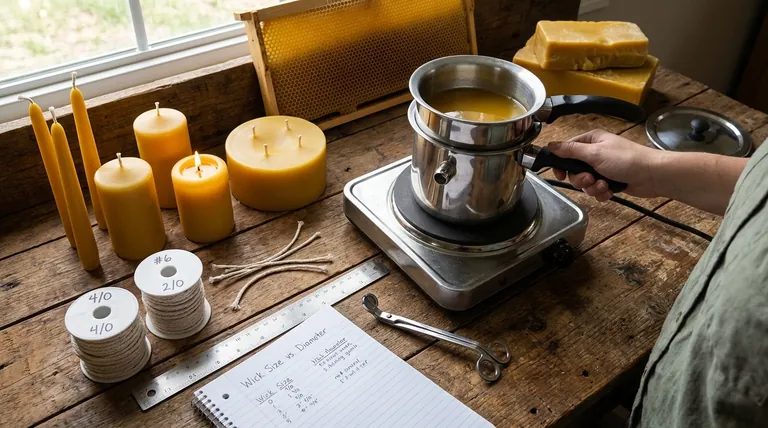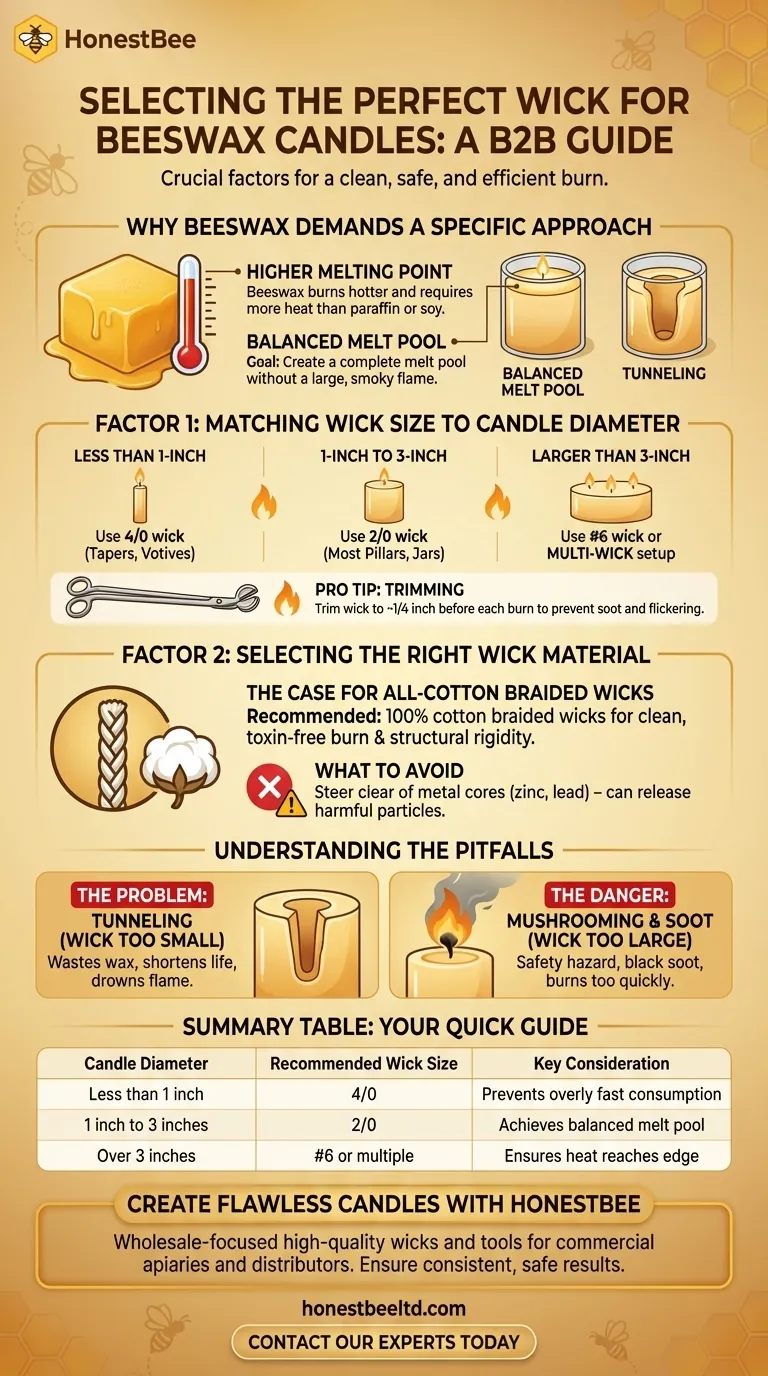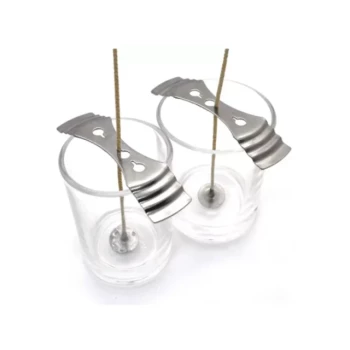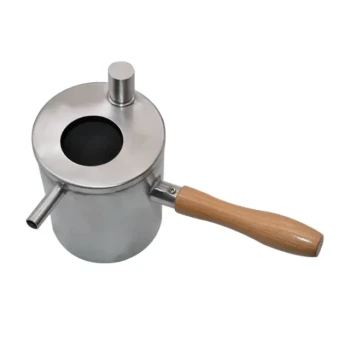Choosing the right wick is the single most important decision for a successful beeswax candle. The two primary factors you must consider are the wick's size, which must be matched to the candle's diameter, and its material. Because beeswax burns hotter and has a higher melting point than common waxes like paraffin or soy, selecting the correct wick is non-negotiable for a clean, safe, and efficient burn.
The core challenge with beeswax is its high melting point. Your wick selection must be precise enough to create a "melt pool" that extends to the edge of the candle without creating an excessively large or smoky flame.

Why Beeswax Demands a Specific Approach
Beeswax is a fundamentally different material than paraffin or soy wax. Understanding its unique properties is the first step in selecting the right components for your candle.
The Higher Melting Point
Beeswax requires more heat to melt than other waxes. This means a standard wick designed for a soy candle of the same size will be underpowered for a beeswax candle.
An underpowered wick will not generate enough heat to melt the wax across the entire diameter, leading to a common problem known as tunneling.
The Goal: A Balanced Melt Pool
The ideal wick creates a melt pool that liquefies the beeswax all the way to the edge of the candle. This ensures an even burn, maximizes the candle's lifespan, and prevents wasted wax along the sides.
The wick acts as the "engine" of the candle. Your job is to select an engine with the right amount of power for the size of the candle.
Factor 1: Matching Wick Size to Candle Diameter
The relationship between wick size and candle diameter is the most critical calculation in candlemaking. A larger diameter candle requires a thicker, more robust wick to generate the necessary heat.
A General Sizing Guide
While testing is always recommended, these standard sizes provide a reliable starting point for all-cotton wicks in beeswax candles:
- Less than 1-inch diameter: Use a 4/0 wick. This is ideal for small tapers or votives.
- 1-inch to 3-inch diameter: Use a 2/0 wick. This is a versatile size for most standard pillar and jar candles.
- Larger than 3-inch diameter: Use a #6 wick or consider a multi-wick setup.
The Importance of Trimming
Regardless of the wick size you choose, it must be trimmed to approximately 1/4 inch before each burn. A wick that is too long will create a large, flickering flame that produces soot.
Factor 2: Selecting the Right Wick Material
The material composition of your wick directly impacts the cleanliness and safety of the burn. Not all wicks are created equal.
The Case for All-Cotton Braided Wicks
It is highly recommended to use 100% cotton braided wicks. These wicks are designed to burn cleanly and completely without releasing toxins or other harmful substances.
Their braided construction provides the structural rigidity needed to stand up straight in the molten beeswax pool.
What to Avoid
Steer clear of wicks that contain metal cores, such as zinc or lead. While once common for adding stiffness, these materials can release harmful particles into the air when burned. Modern cotton wicks achieve the necessary rigidity through superior braiding techniques.
Understanding the Pitfalls
Selecting the wrong wick leads to two common, and opposite, failures. Recognizing them will help you troubleshoot your candle-making process.
The Problem: Tunneling (Wick Too Small)
If your wick is too small for the candle's diameter, it won't generate enough heat. The candle will burn straight down the center, leaving a thick wall of unused wax.
This wastes wax, dramatically shortens the candle's usable life, and will eventually cause the small flame to extinguish itself as it drowns in a small pool of its own wax.
The Danger: Mushrooming and Soot (Wick Too Large)
If your wick is too large, it will pull up more wax than it can cleanly burn. This creates a dangerously large flame, produces black soot, and causes a "mushroom" of excess carbon to form on the wick's tip.
A candle with an oversized wick is a safety hazard and will burn through its wax far too quickly.
Making the Right Choice for Your Project
Use your primary goal to guide your wick selection. Always consider performing a test burn with a small batch before committing to a large production run.
- If your primary focus is thin taper candles (under 1"): Select a small wick like a 4/0 to ensure the flame is proportional and doesn't consume the wax too quickly.
- If your primary focus is standard pillar or jar candles (1" to 3"): A medium-sized 2/0 wick is the most reliable starting point for achieving a balanced melt pool.
- If your primary focus is wide-diameter candles (over 3"): You must use a large wick like a #6 or multiple wicks to ensure the melt pool can reach the container's edge.
Ultimately, proper wick selection is the foundation for creating a beautiful, long-lasting, and safe beeswax candle.
Summary Table:
| Candle Diameter | Recommended Wick Size | Key Consideration |
|---|---|---|
| Less than 1 inch | 4/0 | Prevents overly fast consumption in tapers/votives |
| 1 inch to 3 inches | 2/0 | Achieves balanced melt pool for pillars/jars |
| Over 3 inches | #6 or multiple wicks | Ensures heat reaches the container's edge |
Create flawless beeswax candles with the right supplies from HONESTBEE. Whether you're a commercial apiary producing candles or a distributor sourcing equipment, our wholesale-focused operations provide the high-quality wicks and candlemaking tools you need for consistent, safe results. Contact our experts today to discuss your specific needs and ensure your beeswax products burn perfectly every time.
Visual Guide

Related Products
- Beeswax Melter for Candle Making Honey Bee Wax Melter
- Metal Wick Holder Centering Devices for DIY Candle Making Candle Wick Holder
- Professional Stainless Steel Wax Melter for Beekeeping and Crafts
- 3D Square Honeycomb Pillar Silicone Candle Molds for Making Beeswax Candles
- Steam Beeswax Melter Wax Warmer for Wax Processing
People Also Ask
- What is the best way to melt beeswax for candles? The Safest Method for Professional Results
- How does a steam wax melter work? A Fast, Efficient Method for High-Quality Wax
- What is the flashpoint of beeswax? Essential Safety and Quality Tips for Beekeepers
- What are the main types of wax melters? Choose the Right Heating Method for Your Needs
- How do water jacket melters function? Achieve Gentle, Scorch-Free Melting for Sensitive Materials



















